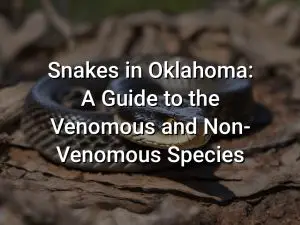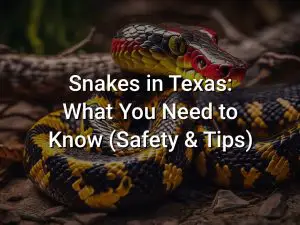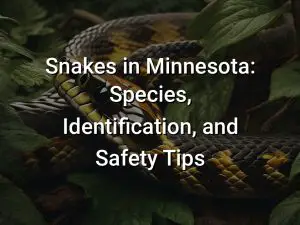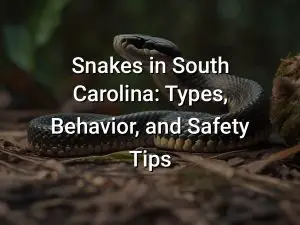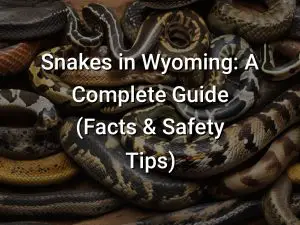Snakes in New York: A Guide to Snake Species and Safety Tips

Did you know that New York is home to a variety of snake species? From the colorful Garter Snake to the venomous Timber Rattlesnake, the state offers a diverse range of these slithering creatures. Whether you’re a snake enthusiast or simply want to learn more, join us as we explore the fascinating world of snakes in New York and discover safety tips for encountering them.
New York may not be the first place that comes to mind when thinking of snakes, but the state is home to several species that play important roles in its ecosystems. From their unique colors and patterns to their fascinating behaviors, snakes are creatures worth learning about. Follow along as we dive into the different snake species you can find in New York and gain valuable insight on how to safely coexist with these amazing reptiles.
Quick Links
Introduction
New York is home to a variety of snake species, each with their own unique characteristics and behaviors. While encountering snakes in the wild can be an exciting experience, it’s important to be knowledgeable about the different species and take precautions to ensure your safety. In this guide, we will explore the various snake species found in New York and provide safety tips for dealing with snakes.
Garter Snake
The Garter Snake is one of the most common snake species found in New York. It is a non-venomous snake with a slender body and distinctive coloration. Garter Snakes have a base color that can range from greenish, brownish, or olive, with three longitudinal stripes running along its body. These stripes can be yellow, white, or green in color.
Garter Snakes are often found in grassy areas, wetlands, and gardens, as they feed on small prey like insects, earthworms, and small amphibians. They are known for their ability to secrete a foul-smelling musk as a defense mechanism when threatened.
These snakes are relatively harmless and rarely bite humans unless provoked or handled. If encountered, it is best to observe them from a safe distance and let them go about their natural behaviors. If you need to handle a Garter Snake, it is recommended to wear gloves and handle them gently to avoid causing stress or harm.
Overall, Garter Snakes play an important role in the ecosystem by controlling populations of small pests. They are a fascinating and harmless snake species that residents of New York may encounter in their surroundings.
Milk Snake
The milk snake is a non-venomous snake species that is commonly found in New York. It is known for its vibrant colors, which consist of bold red, black, and yellow bands. These bands often resemble the venomous coral snake, but the milk snake is harmless to humans.
Milk snakes are often found in woodlands, grasslands, and farmlands, where they feed on small rodents, birds, eggs, and reptiles. They are primarily active at night and are secretive creatures, usually hiding under logs or rocks during the day.
One interesting behavior of the milk snake is its ability to mimic the appearance and behavior of the venomous copperhead snake. When threatened, the milk snake will often vibrate its tail, flatten its head, and strike in a manner similar to the copperhead. This behavior can be intimidating, but remember that the milk snake is not venomous.
If you encounter a milk snake in the wild, it is best to observe from a distance and let the snake go about its business. Milk snakes play an important role in controlling rodent populations, so they are beneficial to have around. However, if you feel the need to relocate a milk snake, it is recommended to contact a professional snake handler or wildlife expert to ensure it is done safely and in compliance with local regulations.
Rat Snake
The Rat Snake is a non-venomous species commonly found in New York. It is known for its adaptability and wide-ranging habitat, making it one of the most common snakes in the state.
Rat Snakes have a distinctive pattern of dark blotches on a lighter background, which can vary in color from yellow to brown. They can grow up to 5-6 feet in length, with some individuals reaching even larger sizes.
These snakes are excellent climbers and are often found in wooded areas, forests, and even suburban neighborhoods. Rat Snakes primarily feed on smaller rodents, hence their name, but they are also known to consume birds and eggs.
If you encounter a Rat Snake in New York, remember that it is harmless and beneficial to have around. Rat Snakes help control rodent populations and play an essential role in the ecosystem. It is best to observe them from a distance and allow them to continue on their way.
If you have a Rat Snake in your yard or home and would like to remove it, it is recommended to contact a professional snake removal service. Attempting to handle or capture a Rat Snake without proper training can be dangerous for both you and the snake.
Black Racer
The Black Racer is a non-venomous snake species commonly found in New York. It is known for its sleek, black appearance and incredible speed. Black Racers are one of the fastest snakes in North America, capable of reaching speeds of up to 10 miles per hour. They are slender and agile, making them excellent climbers and swimmers.
These snakes are diurnal, which means they are active during the day. They can often be seen basking in the sun or hunting for prey, which primarily consists of small mammals, birds, and lizards. Black Racers are constrictors, meaning they will squeeze their prey until it suffocates before swallowing it whole.
Despite their intimidating name, Black Racers are generally non-aggressive towards humans. When threatened, they will usually flee rather than engage in a confrontation. They may vibrate their tail rapidly against leaves or grass, producing a buzzing sound that can be mistaken for a rattlesnake, further deterring potential predators.
If you encounter a Black Racer in the wild, it is important to give it space and observe from a safe distance. Do not attempt to handle or provoke the snake, as this can lead to defensive behaviors. Remember, snakes play a vital role in maintaining balance in the ecosystem, so it is best to appreciate them from afar.
It is worth noting that while Black Racers are harmless to humans, they have been known to bite if they feel threatened. Their bite is non-venomous and usually results in minor injuries, such as puncture wounds or scratches. However, it is always best to avoid handling them to prevent any unnecessary harm.
If you come across a Black Racer in your yard or home, it is recommended to contact a professional snake removal service to safely and humanely relocate the snake. It is important to remember that snakes, including the Black Racer, are protected wildlife in New York and should not be harmed or killed.
Overall, the Black Racer is a fascinating snake species found in New York. Its sleek appearance and incredible speed make it a sight to behold in the wild. Remember to respect and appreciate these creatures from a safe distance, as they play an important role in the ecosystem.
Eastern Massasauga Rattlesnake
The Eastern Massasauga Rattlesnake is a venomous snake species found in New York. It is a small and relatively rare snake, typically measuring around 2 to 3 feet in length. It has a distinct rattling noise that it produces by shaking its tail, serving as a warning to potential predators or threats.
This snake species primarily inhabits wetland areas such as marshes, swamps, and bogs. They are known to be most active during the warmer months, and are often found basking in the sun or hunting for prey.
The Eastern Massasauga Rattlesnake has a striking pattern of dark brown or black markings on a light brown or gray background. These markings may take the form of blotches or alternating bands along the length of the snake’s body.
It is important to note that the Eastern Massasauga Rattlesnake is a venomous snake and should be treated with caution. If you encounter one in the wild, it is best to observe from a safe distance and avoid any attempts to handle or provoke the snake.
If you are bitten by an Eastern Massasauga Rattlesnake, seek immediate medical attention. Symptoms of a bite may include swelling, pain, and discoloration around the bite area, as well as potential systemic effects such as difficulty breathing or changes in heart rate.
It is worth mentioning that the Eastern Massasauga Rattlesnake is considered a threatened species and is protected by law in New York. It is illegal to harm, kill, or capture these snakes without appropriate permits or licenses.
When exploring areas where snakes may be present, such as wetlands or hiking trails, it is important to take precautions to ensure your safety. Stay on designated trails, avoid tall grass or underbrush where snakes may hide, and wear sturdy footwear to protect against potential snake bites.
If you encounter a snake in your backyard or property, it is advisable to contact local wildlife authorities or animal control for assistance with safely removing the snake.
Eastern Hognose Snake
The Eastern Hognose Snake, also known as the puff adder, is a non-venomous snake found in New York. It is identifiable by its upturned snout and its ability to flatten its head to resemble a cobra. The Eastern Hognose Snake is known for its defensive behavior of feigning death when threatened. It will flatten its body, open its mouth, and even emit a foul odor to deter predators.
This snake species can grow up to 3 feet in length and has a coloration that varies from brown to gray with dark blotches or speckles. It primarily feeds on toads and frogs, as it has adapted to tolerate the toxins secreted by these prey.
The Eastern Hognose Snake is not aggressive towards humans and will typically try to avoid confrontation. However, if cornered or handled, it may hiss, strike, or even play dead as a defense mechanism. It is important to respect their space and observe them from a safe distance in their natural habitat.
If you encounter an Eastern Hognose Snake in the wild, appreciate its unique characteristics and the important role it plays in the ecosystem. Remember to give it the space it needs and avoid attempting to handle or disturb it.
Northern Water Snake
The Northern Water Snake is a species of non-venomous snake found in New York. They are often mistaken for venomous water moccasins due to their similar appearance, but they pose no threat to humans and are beneficial to the ecosystem.
These snakes are commonly found near bodies of water such as lakes, ponds, and streams. They have a dark-colored patterned body, usually brown or black, with lighter colored bellies. Northern Water Snakes are known for their ability to swim and are often seen basking on rocks or tree branches near the water.
While they are harmless to humans, Northern Water Snakes can be aggressive when threatened or cornered. They will release a strong musky odor and may bite if provoked. It’s important to remember that they are protected under state law and should not be harmed or killed.
If you encounter a Northern Water Snake, it’s best to observe from a safe distance and avoid any actions that may provoke it. Keep in mind that they play an important role in the ecosystem by controlling populations of small mammals and fish.
By respecting the natural habitat of the Northern Water Snake and exercising caution when encountering them, we can coexist with these fascinating reptiles in harmony.
Eastern Ribbon Snake
The Eastern Ribbon Snake (Thamnophis sauritus) is a non-venomous snake species commonly found in New York. It is a slender and elegantly patterned snake with a distinct yellow or white stripe running its length, bordered by black stripes on either side.
Eastern Ribbon Snakes prefer habitats near wetlands, marshes, and bodies of water, as they are excellent swimmers and thrive in aquatic environments. They are most active during the day and feed on small amphibians, fish, and invertebrates.
This species is relatively small, usually averaging between 20 to 30 inches in length, with females slightly larger than males. The Eastern Ribbon Snake has a docile temperament and is known for its agility and speed, making it challenging to catch.
When threatened, Eastern Ribbon Snakes may release a musky odor or attempt to flee. They are not harmful to humans and are primarily beneficial to the ecosystem, helping to control populations of small animals and insects.
If you encounter an Eastern Ribbon Snake in New York, it is important to appreciate their beauty from a distance and allow them to go about their natural behaviors. Do not attempt to handle or disturb them, as it can cause unnecessary stress to the snake and increase the risk of injury.
Remember, snakes play a vital role in maintaining a balanced ecosystem, and respecting their presence is essential for their conservation and our safety.
Timber Rattlesnake
The Timber Rattlesnake is a venomous snake species that can be found in New York. It is the largest venomous snake in the state and can grow up to 4 to 5 feet in length. The Timber Rattlesnake is known for its distinctive rattling sound, which it uses as a warning sign when it feels threatened.
This snake is primarily found in forested areas with rocky outcrops, as they provide the perfect habitat for hunting and hibernation. The Timber Rattlesnake is a master of camouflage, with a patterned body that blends in well with its surroundings.
While the Timber Rattlesnake is venomous, it is generally not aggressive towards humans and will only bite in self-defense. However, it is important to keep a safe distance if you encounter one in the wild. If you encounter a Timber Rattlesnake, it is best to slowly back away and give it space. Do not attempt to provoke or handle the snake.
If you are bitten by a Timber Rattlesnake, seek medical attention immediately. The venom of this snake can cause severe pain, swelling, and other symptoms. It is important to stay calm and keep the affected area immobilized until you can receive medical treatment.
When exploring areas where Timber Rattlesnakes may be present, it is important to wear sturdy boots and long pants to protect yourself from potential bites. Avoid reaching into crevices or under rocks where snakes may be hiding.
Overall, while the Timber Rattlesnake is a fascinating species, it is important to exercise caution and respect when encountering them in the wild to ensure both your safety and the snake’s.
Northern Copperhead
The Northern Copperhead is a venomous snake species that can be found in certain areas of New York. It is characterized by its distinct copper-colored head and chevron-shaped markings along its body.
While the Northern Copperhead is venomous, it is generally a shy and non-aggressive snake. It prefers to avoid human interaction and will typically only bite if threatened or provoked. The venom of the Northern Copperhead is designed to immobilize its prey and is rarely fatal to humans, although bites should still be taken seriously.
If you encounter a Northern Copperhead in the wild, it is important to remember the following safety tips:
- Do not try to handle or disturb the snake in any way.
- Keep a safe distance and give the snake space to retreat.
- Wear appropriate protective clothing, such as long pants and closed-toe shoes, when exploring snake habitats.
- Be cautious when stepping over logs, rocks, or other potential hiding places for snakes.
- Stay on designated trails and avoid walking through tall grass or underbrush where snakes may be hiding.
- If you are bitten by a Northern Copperhead, seek immediate medical attention. Do not attempt to treat the bite yourself.
By being aware of the presence of Northern Copperheads and following these safety tips, you can help ensure a safe and enjoyable outdoor experience in areas where these snakes may be found.
Safety Tips for Dealing with Snakes
Snakes are fascinating creatures, but it’s important to know how to safely interact with them to avoid any potential harm. Here are some safety tips for dealing with snakes:
- Stay calm: If you encounter a snake, try to remain calm. Most snakes in New York are nonvenomous and pose little threat to humans.
- Keep your distance: Maintain a safe distance from the snake. Do not attempt to touch or corner it, as this may provoke a defensive response.
- Identify the snake: Take note of the snake’s appearance, but do so from a safe distance. This information can help you determine if it is venomous or nonvenomous.
- Leave it alone: In most cases, it’s best to leave the snake alone and allow it to continue on its way. Snakes play a vital role in maintaining the ecosystem and help control rodent populations.
- Avoid snake habitat: Be aware of your surroundings and avoid areas where snakes are commonly found, such as tall grass, brush, or rocky areas.
- Protect your property: Keep your yard and outdoor spaces well-maintained to minimize potential snake habitats.
- Prevent snake entry: Seal any gaps or openings around your home to prevent snakes from entering. This includes gaps in doors, windows, and foundation walls.
- Wear appropriate gear: If you’re hiking or exploring areas where snake encounters are possible, wear long pants, sturdy boots, and gloves to protect yourself.
- Teach children: Educate children about snake safety and encourage them to alert an adult if they encounter a snake.
- Call a professional: If you have concerns or come across a snake that you believe may be dangerous, contact a local wildlife professional or animal control agency for assistance.
Remember, the majority of snakes encountered in New York are harmless and play an important role in the ecosystem. By following these safety tips, you can coexist with snakes and appreciate their unique beauty from a safe distance.
Conclusion
New York is home to a diverse range of snake species, each with its own unique characteristics and behaviors. While encountering a snake in the wild can be a thrilling experience, it’s important to prioritize safety and understanding.
By familiarizing yourself with the different snake species found in New York and following the safety tips outlined in this guide, you can confidently navigate snake encounters and coexist with these fascinating creatures. Remember to always keep a safe distance, avoid handling snakes, and seek professional assistance if needed. With a little knowledge and respect, you can appreciate the natural beauty of New York’s snakes while keeping yourself and the snakes safe.

